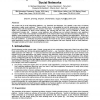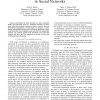CSE
2009
IEEE
13 years 11 months ago
2009
IEEE
—The hidden knowledge in social networks data can be regarded as an important resource for criminal investigations which can help finding the structure and organization of a crim...
CSE
2009
IEEE
13 years 11 months ago
2009
IEEE
—The success of a Public Key Infrastructure such as the Web of Trust (WoT) heavily depends on its ability to ensure that public keys are used by their legitimate owners, thereby ...
CSE
2009
IEEE
13 years 11 months ago
2009
IEEE
—This paper presents a model of collaborative decision-making for groups that involve people and computer agents. The model distinguishes between actions relating to participants...
CSE
2009
IEEE
13 years 11 months ago
2009
IEEE
—Due to the exponential growth of information on the Web, Recommender Systems have been developed to generate suggestions to help users overcome information overload and sift thr...
CSE
2009
IEEE
13 years 11 months ago
2009
IEEE
—The recently developed small wireless devices ranging from sensor boards to mobile phones provide a timely opportunity to gather unique data sets on complex human interactions, ...
CSE
2009
IEEE
13 years 11 months ago
2009
IEEE
The current set of social networking platforms, e.g. Facebook and MySpace, has created a new class of Internet applications called social software. These systems focus on leveragi...
CSE
2009
IEEE
13 years 11 months ago
2009
IEEE
Abstract—We present here a method for analyzing the neighborhoods of all the vertices in a large graph. We first give an algorithm for characterizing a simple undirected graph t...
CSE
2009
IEEE
13 years 11 months ago
2009
IEEE
Abstract—Social networks can be used to model social interactions between individuals. In many circumstances, not all interactions between individuals are observed. In such cases...
CSE
2009
IEEE
13 years 11 months ago
2009
IEEE
Recent research identifies a growing privacy problem that exists within Online Social Networks (OSNs). Several studies have shown how easily strangers can extract personal data a...
CSE
2009
IEEE
13 years 11 months ago
2009
IEEE
—Individuals in social networks are often organized under some hierarchy such as a command structure. In many cases, when this structure is unknown, there is a need to discover h...


